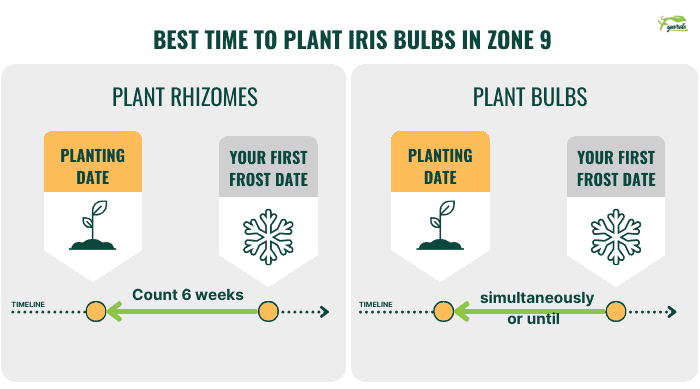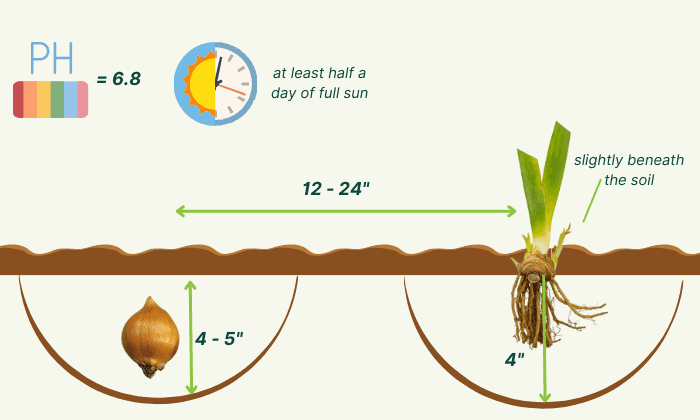Irises are straightforward to grow and hardy up to zone 9, where winters are mild and temperatures are warm throughout the growing season. You only need to sow irises in November or April, though November is the better time for planting.
For more tips on when to plant iris bulbs in zone 9, keep on reading.
Best Time to Plant Iris Bulbs in Zone 9
Irises generally grow from rhizomes or bulbs.
- Species that grow from bulbs, such as Dutch, Spanish, and Dwarf irises, must be planted in the fall, as they need to undergo cold dormancy before flowering in spring.
- Rhizome irises will also benefit from a fall planting, but one can also grow them in the spring. The only caveat is that they may not bloom in summer or fall, or in the event that they do, the plants will be weaker.
Cultivars that fall under this category include beardless, crested, and bearded iris.
To help you determine what month to plant both types, here are some tips:
- Sow irises in the spring when the ground is workable.
- For fall planting, plant rhizomes six weeks before the first frost. Bulbs may be sown at the same time or up until the first freeze, considering they are hardier than rhizomes and require less time to establish before winter arrives.
- Container irises can be put in the ground at any time, though earlier transplanting is better.
- In case you’re wondering “is it too late to plant irises?” zone 9b and 9a experience their first frost around December 15. Six weeks before this date would be November 3, but it’s better to look up the frost estimate of your locality for accuracy.
Here are the dates for some locations in hardiness zones 9a and 9b.
| Location & Growing zones | Average first frost |
| Houston, Texas (zone 9a) | December 8 |
| Las Vegas, Nevada (zone 9a) | December 1 |
| St. Marys, Georgia, (zone 9a) | December 27 |
| Biloxi, Mississippi (zone 9a) | December 2 |
| Bakersfield, California (zone 9b) | December 1 |
| New Orleans, Louisiana (zone 9b) | December 9 |
| Orlando, Florida (zone 9b) | January 3 |
| Tucson, Arizona (zone 9b) | December 9 |
Related:
Zone 9 Iris Bulb Planting Tips
Plant iris bulbs four to five inches deep and rhizomes just slightly beneath the soil.
You should spread the rhizome roots towards the sides and cover them with an inch of soil. However, the mounds in which they sit should still be four inches deep, and you must backfill the holes before watering.
Irises prefer loose ground with a pH of 6.8, at least half a day of full sun, and a spacing of 12 to 24 inches between plants.
Fertilizing is best done in early spring and after flowering, with an all-purpose, 1-2-2 slow-release formula watered into the top layer of the soil.
It’s also essential to do the following:
- Avoid mulching to prevent rot.
- Divide iris bulbs and rhizomes every three to four years for fresh, consistent blooms.
Dig up the rhizomes after they bloom and pull the clumps apart by hand, discarding the one in the middle while keeping the outer clumps for replanting.
With bulbous irises, wait until the foliage dies back to unearth the bulbs, then keep only the viable ones for sowing.
- Just as importantly, control iris borers by removing debris and dead leaves. Dispose of and burn all infected plant parts to prevent the further spread of disease.
Conclusion
When to plant iris bulbs in zone 9 is not that hard to determine. These flowers grow best under the mild, cool weather of fall, and they will bloom from late spring to summer if you plant multiple varieties in your garden, such as bearded, Siberian, and Louisiana irises.
We wish you success in growing these flowers in your yard. Leave us a message if you have any questions.

Hi, I am William – Floridayards’ digital content creator. My job is to find answers to all your concerns with thorough research and our team’s expert advice. I will also bring you honest reviews on the best products and equipment for raising your beautiful garden. Please look forward to our work!













